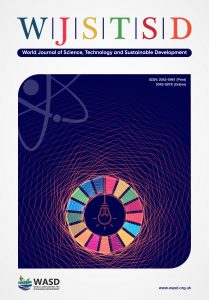Modelling green productivity spillover effects on sustainability, Prof. Elsadig Ahmed
Prof. Elsadig Musa Ahmed
Faculty of Business
Multimedia University, Melaka
Malaysia
Email: elsadigmusa@yahoo.com
DOI: 10.1108/WJSTSD-01-2020-0009
Purpose: This study aims to explain the integration of innovation and climate with the economic growth Green Productivity (GP) concept. This is drawn from the integration of two important developmental strategies: productivity improvement and environmental protection. Productivity provides the framework for continuous improvement, while environmental protection provides the foundation for sustainable development. Therefore, GP is a strategy for enhancing productivity and environmental performance for overall socio-economic development.
Design/methodology/approach: Three variations of frameworks and econometric model were developed to measure green total factor productivity, green labour productivity and green capital productivity, and their contributions to green productivity and sustainable development; these were based on extensive and intensive growth theories.
Findings: The sustainability of higher economic growth will likely continue to be productivity driven. This will be through the enhancement of total factor productivity (TFP) as technological progress in nations that combined the three dimensions of sustainable development (economic development, environmental protection and social sustainable development via human capital development). Such an enhancement needs to emphasise the quality of the workforce, demand intensity, economic restructuring, capital structure, technical progress and environmental standards. It should be recalled that green productivity through green TFP demonstrates the sustainable development concept of progressing technologically. It will ensure the rights of the future, as well as current, generations for them to enjoy a better life.
Originality/value: The study fills the gaps in growth theories by developing three variations of frameworks and econometric models, and internalising pollutants emissions as private and unpriced inputs in the three models. Further, the green capital productivity model is the sole contributing model developed in this research; it has not been thought about in any previous studies. This study highlighted the green productivity that is ignored by the studies that have been awarded the Nobel Prize in economic sciences in 2018.
Keywords: Sustainable development; Green productivity; TFP; Labour productivity; Capital productivity.
Citation: Ahmed, E.M. (2020), "Modelling green productivity spillover effects on sustainability", World Journal of Science, Technology and Sustainable Development, Vol. 17 No. 3, pp. 257-267. https://doi.org/10.1108/WJSTSD-01-2020-0009

